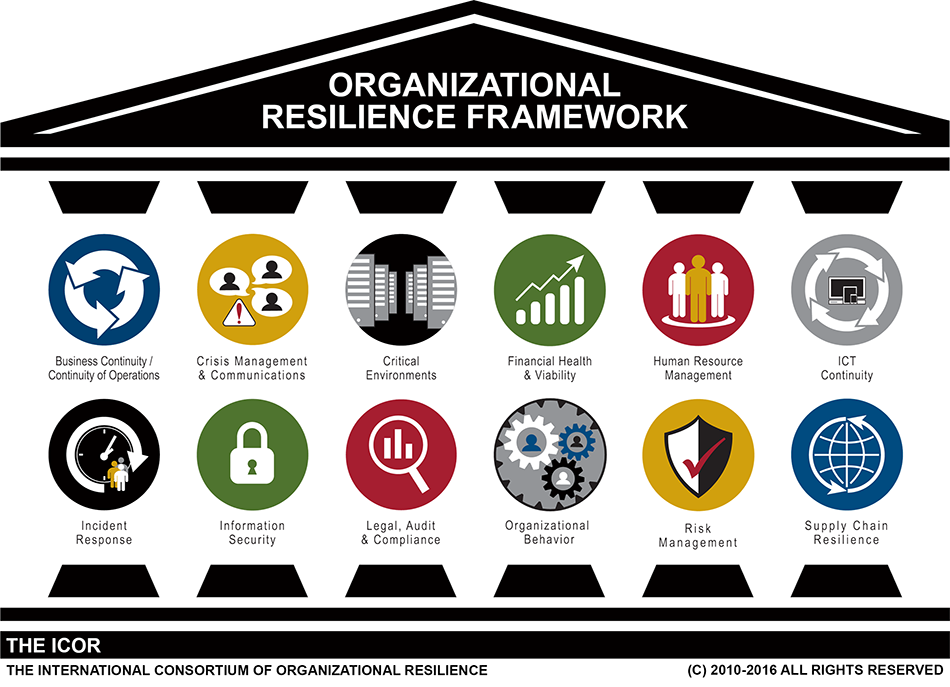ICOR’s Organizational Resilience Framework identifies twelve management disciplines that effectively manage risk. Each of these disciplines must be implemented as a system and then each system integrated into one framework. It is essential to eliminate silos. Click on each discipline to learn more.

In addition to effectively managing risk, it is just as important that the organization has effective and empowered leaders at all levels, leaders who are trusted and respected, and leaders who can make decisions.
Resilience requires a coordinated approach.
While there is no single strategy or solution to make an organization resilient, an organization can enhance its resilience by:
- Strengthening of individual management disciplines of the organization that manage risk and doing so in an integrated and coordinated manner.
- Building a culture that ensures the organization behaves in a healthy manner.
- Increasing its adaptive capacity and ability to manage change.
Each of these aspects plays an important role in building a more resilient organization, but implemented as a framework and as an integrated strategy will bring the most benefit.

Business Continuity / Continuity of Operations
Business Continuity Management (BCM) is a management process that identifies potential threats to an organization and the impacts to business operations if those threats are realized.
Crisis Management and Communications
The Crisis Management & Communication Discipline addresses crises that are managed primarily by top management and at a strategic level of the organization.
Critical Environments
The focus of the Critical Environments discipline is on the design, build, operations, management, governance, and audit of data centers and other critical environments used to house computer systems, and associated components such as telecommunications and storage systems.
Financial Health & Viability
Organizational resilience is more than managing risk, engaging leadership, and having a healthy culture. The organization must be financially viable and provide a product or service under changing conditions.
Human Resource Management
Human Resource Management is a business field focused on maximizing employee productivity. It is a function in organizations designed to maximize employee performance in service of an employer’s strategic objectives. Human Resource Management also concerns itself with managing and encouraging organizational change.
Information & Communication Technology Continuity
The discipline of Information and Communication Technology (ICT) addresses the need for organizations to protect their technology and telecommunication systems and to minimize the impact of disruptions.
Incident Response
The focus of this discipline is on the planning needed for an effective response to an incident. Organizations need to have procedures in place to manage an incident that impacts life safety and physical assets.
Information Security
Today more than ever, computer system threats need to be both understood and protected against at the highest level possible. With the increase in threats the field of information security has grown and evolved.
Legal, Audit, and Compliance
The Legal, Compliance and Audit discipline plays two roles in organizational resilience. First, it is a collection of best practices as determined by various industry groups, oversight organizations, and government agencies. Second, inspection procedures up to and including third-party audits are available to ensure alignment with the practices.
Organizational Behavior
Organizational Behavior is the study of human behavior in organizational settings, the interface between human behavior and the organization, and the organization itself.
Risk Management
Risk management is the identification, assessment, and prioritization of risks (defined in ISO 31000 as the effect of uncertainty on objectives) followed by coordinated and economical application of resources to minimize, monitor, and control the probability and/or impact of an incident or to maximize the realization of opportunities.
Supply Chain Management
Threats to your supply chain and therefore to your organization abound – their likelihood and consequences heightened by long, global supply chains, ever-shrinking product cycles, and volatile and unpredictable market cycles.